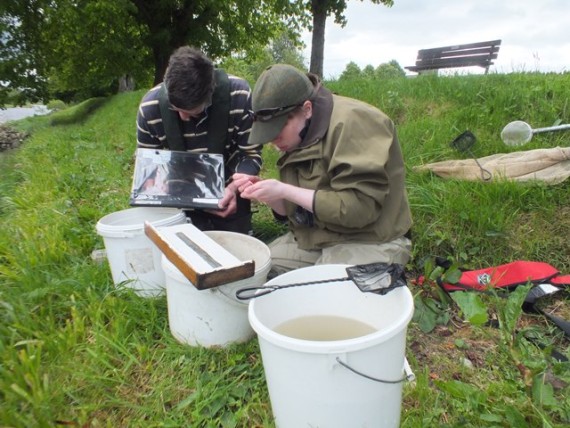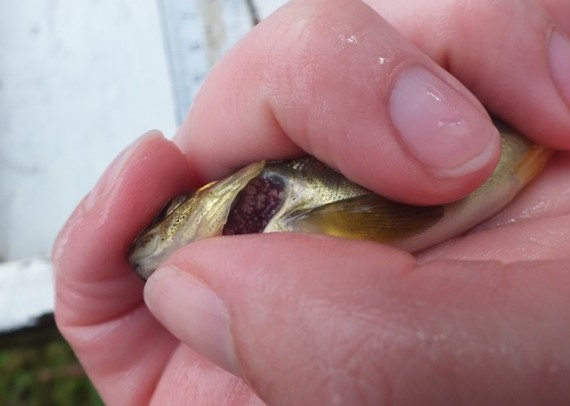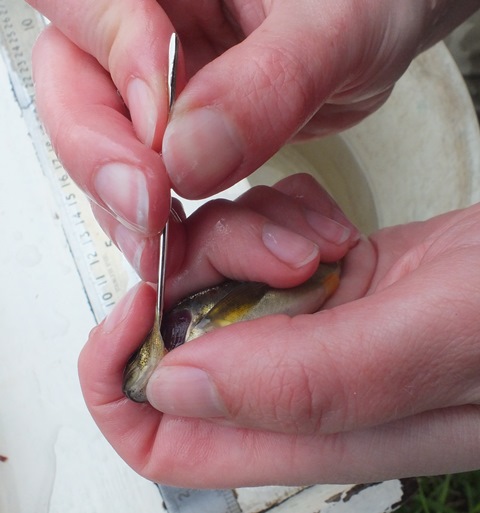The Spey is a Special Area of Conservation for a number of different species including salmon and freshwater pearl mussels. The decline in the Spey salmon catch has been well documented but the pearl mussel population has also declined with a 50% reduction in population size recorded in the last decade. One feature of the pearl mussel lifecycle that is not well known is their reliance on salmon and/or trout parr for the first overwinter stage. In summer the adult mussels “spat” or release fertile larvae mussels into the water column. These larvae are short lived and they have to attach to the gills of a salmon or trout almost immediately. If the larvae are fortunate enough to pass through a fishes gills and attach they become encysted on the gills and in the spring/early summer of the following year can be seen by the naked eye. In the summer of that year the surviving glochidia drop of the fishes gills and settle into the river substrate for the next stage of their life. See here for an explanation of the life cycle of freshwater pearl mussel.
It appears from research that the mussel larvae are not always found equally on salmon and trout, even where both species are present; in some rivers they are more common on trout parr even when salmon parr are more abundant.
Some work on encystment in the Spey was carried out a number of years ago but given the concern about the status of the population Elizabeth Clements, a Masters Student from the Scottish Centre for Ecology and the Natural Environment, Loch Lomond (mussel boffin!), visited the river to assess the situation. We were delighted to assist by electrofishing at a few sites along the river from Grantown downstream. I joined the team this morning at Aberlour to see the technique in action.
The electrofishing site in Aberlour normally supports a lot of parr so it was not difficult to catch the 50 or so required. Most of the parr at this time of year, and in this part of the river, are 1+ years old and generally below 100mm, most of the larger parr having emigrated as smolts.

Elizabeth and Steve checking the gills for glochidia at Aberlour.
My eyesight is not what it used to be but I could make out the encysted glochidia on fish where they were present. I didn’t stay till the end nor take a note of the results but about 20% of the salmon parr appeared to support glochidia, a few with 100+.

This salmon parr supported a high number of glochidia which can be seen as white spots on the gill.

The assessment technique was not high tech! The key component was a darning needle - not too sharp but pointy enough to lift each gill arch in turn.
It was very interesting to see the survey technique in action and good to see that there appeared to be glochidia on the gills of many fish. Scaled up across the whole river the number of infected fish must be large. It is considered that the role of carrying glochidia overwinter doesn’t harm the parr, indeed they were all in superb condition today.
No trout were caught at the Aberlour site but further upstream some were but they supported no glochidia. Hitching a ride on the gills of salmonids also provides a mechanism by which the pearl mussels can overcome that perennial problem for all river dwelling life - how do you counteract the continual downstream direction of travel? Some of the infected parr will migrate upstream before shedding the glochidia, thereby providing a mechanism for the species to at least maintain its range in the river.
The post Salmon parr and freshwater pearl mussels appeared first on Spey Fishery Board.
Spey Fishery Board
